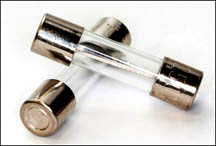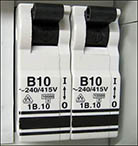When you turned on all three appliances, the total usage was 46.25 amperes at the same time. Since these appliances were all being used in one small room (the bathroom), they were probably all wired to a single, smaller circuit within your home. But why did they all go out?
To prevent wires from overheating, safety devices are installed in homes to limit the amount of electricity that can flow through the wires. These devices are called fuses (shown bottom left) and circuit breakers (shown bottom right). In order to understand the overload problem you experienced in the bathroom, you need to learn about these.


As you now know, electric power is brought into your house in one large power line from the street. Inside your house it is divided up into several different circuits. Most houses have about 5 to 15 circuits. Most house circuits are wired for 120-volts. 240-volt circuits are used for particular circuits that run major appliances like electric clothes dryers, water heaters, well pumps, ceramic kilns, or electric stoves that require large amounts of electricity.
Circuits
What voltage are most home circuits wired for?
Most home circuits are 120 volts.
Safety
What are the safety devices that shut off the electricity to the bathroom called?
Fuses and Circuit Breakers
